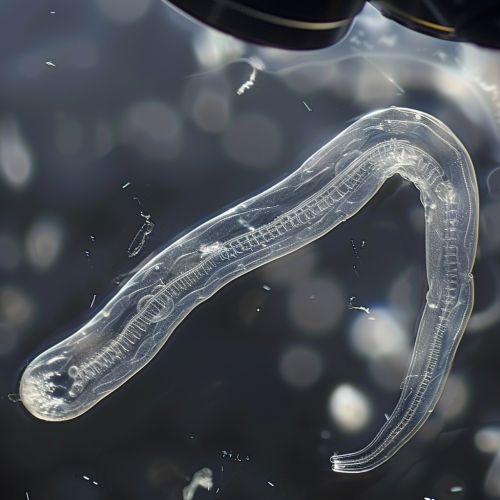C. elegans
Introduction
C. elegans is a free-living, transparent nematode (roundworm), about 1 mm in length, which lives in temperate soil environments. The name "Caenorhabditis elegans" comes from the Greek for "new rod" and "elegant". It is one of the simplest organisms with a nervous system.


Biology and Anatomy
C. elegans has a simple anatomy, consisting of approximately 1,000 somatic cells, of which about 300 are neurons. The body is covered by a cuticle, a tough and flexible exoskeleton, which is used for protection and locomotion. The worm's body also contains a complete digestive tract and a reproductive system.
Nervous System
The nervous system of C. elegans is a key area of study due to its simplicity and the ease with which it can be manipulated. It is composed of 302 neurons, which are responsible for the worm's behavior. The neurons are connected by synapses and gap junctions, forming a neural network.
Reproduction
C. elegans is a hermaphrodite, which means that each worm contains both male and female reproductive organs. The worms can self-fertilize or mate with males to produce offspring. The process of reproduction in C. elegans is a major area of study in developmental biology.
Genetics
The genome of C. elegans was the first multicellular organism's genome to be sequenced. The genome contains approximately 20,000 protein-coding genes. The study of C. elegans genetics has led to important discoveries in biology, including the process of programmed cell death, RNA interference, and the role of microRNAs in gene regulation.
Research and Contributions to Science
C. elegans has been used as a model organism in scientific research for several decades. It has contributed to our understanding of many fundamental biological processes, including cell division, neural development, aging, and apoptosis. The simplicity of its biology and its amenability to genetic manipulation make it a valuable tool for scientists.
Aging Research
C. elegans has been extensively used in the study of aging and lifespan. The worms have a short lifespan, which allows researchers to study the effects of genetic and environmental interventions on aging over a short period of time.
Neurobiology
The simple nervous system of C. elegans has made it a model organism for the study of neurobiology. Researchers have used the worm to study neural development, function, and degeneration.
Cell Death and Apoptosis
C. elegans has also been instrumental in the study of cell death and apoptosis. The process of programmed cell death was first discovered in C. elegans.
Conclusion
C. elegans is a powerful model organism that has contributed significantly to our understanding of fundamental biological processes. Its simple anatomy, ease of manipulation, and the wealth of genetic tools available make it an ideal organism for scientific research.
